| s/y Nine of Cups Great Basin National Park, Nevada May 2012 |
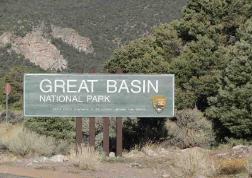
| Great Basin National Park, established in 1986, is located in eastern Nevada near the Utah border. The park is most notable for its groves of ancient bristlecone pines, the oldest living things on earth, and for the Lehman Caves at the base of Wheeler Peak. The park protects ~77,180 acres of contiguous wildlife habitat and wilderness. |
| What is the Great Basin? The Great Basin is the largest area of contiguous endorheic watersheds in North America. Basically, it is a closed drainage basin that retains water and allows no outflow to other bodies of water such as rivers or oceans. Normally, water that has accrued in a drainage basin eventually flows out through rivers or streams or by underground diffusion through permeable rock, ultimately ending up in the oceans. However, in the Great Basin, rain (or other precipitation) that falls within it does not flow out but may only leave the drainage system by evaporation and seepage. John C. Fremont, trained as a topographical engineer, possessed an expertise unprecedented in western exploration and published the earliest reports and surveys of the area. (from various internet sources) |
| "Discovered" and exploited by Absalom Lehman in 1885, these caves were well known by the native Americans long before Lehman explored them. The million-year-old cave extends a quarter mile into the limestone and marble that banks the base of the Snake Range. Most noted for its abundance of formations known as "shields", Lehman Caves is one of the most profusely "decorated" caves in the region. |
| Animals who use caves fall into several different categories. A trogloxene is a species who uses caves, but does not spend its entire life cycle within one, e.g. chipmunks, mice and pack rats. These animals are dependent on vegetation for food and must leave regularly to forage. Bats feed on flying insects, such as mosquitos, and so must also must leave the cave to find adequate food. The nesting material brought into the cave and droppings left behind by these temporary residents is a major source of nourishment for another type of animal known as a troglobite. Troglobites are species that spend their entire life cycles in caves and include cave crickets, spiders, psuedoscorpions and the smaller mites and springtails. Often troglobites have adapted to the cave environment through morphological changes such as the loss of eyes and pigment and lengthening of appendages. Lehman Caves is inhabited by several endemic troglobites including the critters listed above and a new species of amphipod (aka freshwater shrimp) was recently discovered by park employees. |
| Nevada is the most mountainous state in the USA with over 300 individual mountain ranges and 42 named summits over 11,000 feet. |
| White nose syndrome (WNS) is a fungal disease that has killed more than one million bats in the USA and Canada. The fungus is named for the white fungus that grows around infected bats' faces and other body parts. WNS results in bats exhibiting abnormal behavior during winter months such as flying during the day and clustering near entrances. In some caves or mines where bats spend the winter, 90 to 100 percent of the bats have died. This epidemic has been called one of the greatest wildlife disasters in our nation's history. Bats make up over 20% of the mammal species on Earth and save the US agricultural industry over 3 billion dollars a year in pest-control services. To protect the Lehman Caves, we were asked several questions regarding our recent travels, asked to verify that we'd not be in any caves in the last year and check our shoes to make sure they had no debris on them. |
| View of the Great Basin from Wheeler Peak Lookout. |
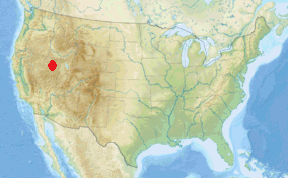
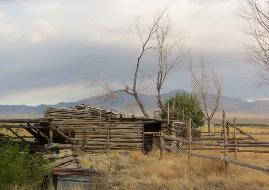
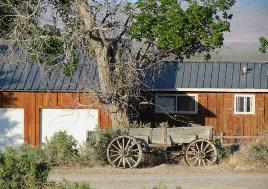
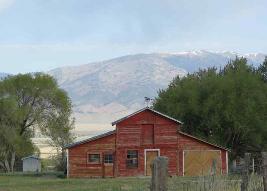
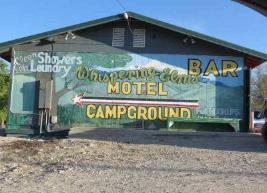
| The park headquarters are located in Baker, Nevada, virtually in the middle of nowhere. We found a room at the Whispering Elms for a couple of nights. Though not many amenities were available, the local scenery was absolutely fantastic and we spent time just photographing the local sights before heading to the national park. |
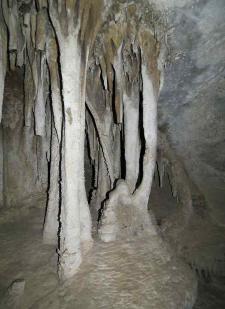
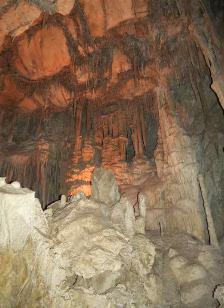
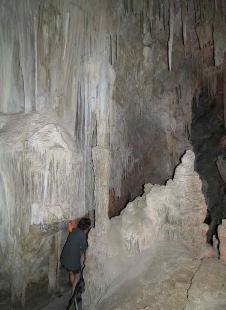
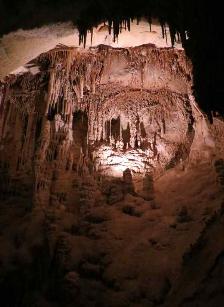
| We booked an early morning tour of the cave and despite a bit of claustrophobia on Marcie's part, we enjoyed our trip below the earth's surface. Columns, stalactites, stalagmites, cave popcorn, shields, draperies and great color...this cave had it all. |
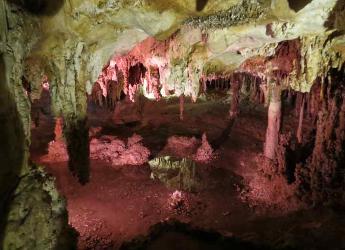
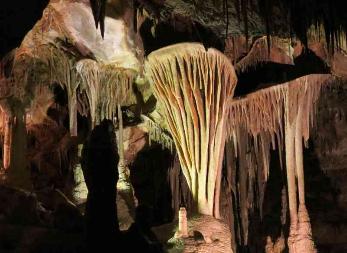
| Above a shield, called the Parachute. |
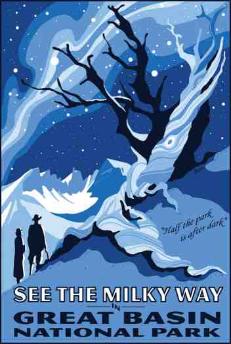
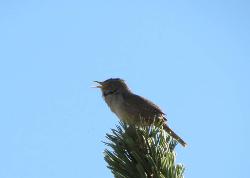
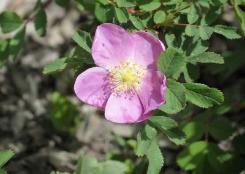
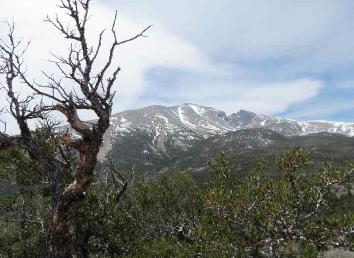
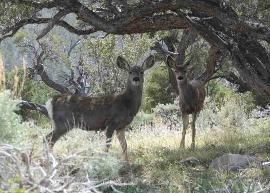
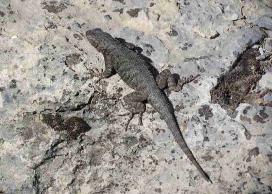
| The remoteness of the area makes it one of the darkest places in America to view the stars...but not on a cloudy night. ;-( |
| A pipit sings us a song |
| A wild rose comes into bloom. |
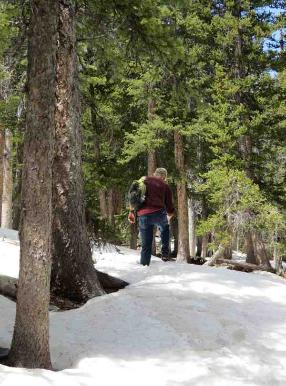
| Much to our disappointment, we were just a wee bit too early for the Bristlecone Pine Trail and finally turned back. |
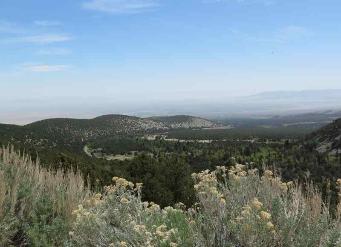
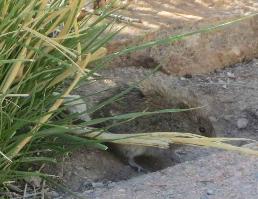
| A packrat scampers through the grass |
| Lizard sunning himself on a warm rock. |
| Mule deer graze |
| View of Wheeler Peak |
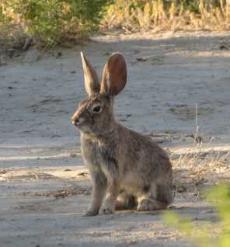
| A jackrabbit poses for a photo |
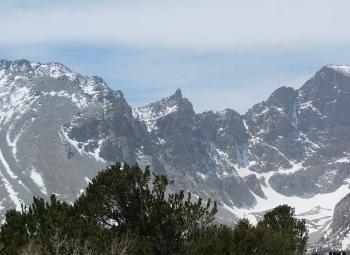
| Wheeler Peak left, the Thumb in the middle and Jeff Davis Peak to the right. |
| Once again, we were a bit too early in the season to be able to hike the trails, BUT we had the park almost to ourselves, the weather was brilliant and the cave tour was great. Not viewing the bristlecone pines was definitely a missed opportunity for us...next time. We'll head to Idaho from here and visit Hagerman Fossil Beds National Monument. Wanna come? |
| More National Parks? More American Odyssey trip? Roadside Americana? Birds of North America? Wildflowers of North America? |
Back to Home Page (already?)
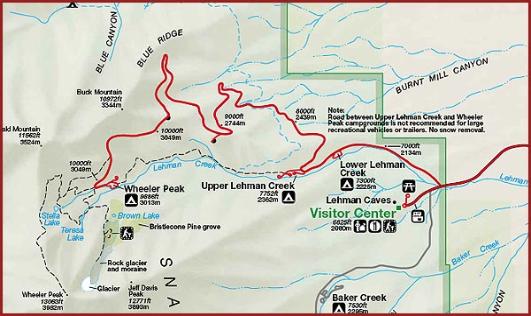
| In addition to 11 species of conifer trees and over 800 species of plants in Great Basin National Park and the neighboring valleys, there are 61 species of mammals, 18 species of reptiles, 238 species of birds, 2 species of amphibians and 8 species of fish. |